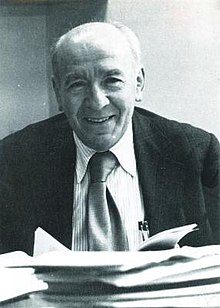Mark Kac
| Mark Kac | |
|---|---|
 |
|
| Born |
August 3, 1914 Krzemieniec |
| Died | October 26, 1984 (aged 70) California |
| Residence | USA |
| Citizenship | Poland, USA |
| Nationality | Polish |
| Fields | Mathematics |
| Institutions |
Cornell University Rockefeller University University of Southern California |
| Alma mater | Lwów University |
| Doctoral advisor | Hugo Steinhaus |
| Doctoral students |
Harry Kesten William LeVeque William Newcomb Lonnie Cross Murray Rosenblatt Daniel Stroock |
| Known for |
Feynman–Kac formula Erdős–Kac theorem |
| Notable awards |
Chauvenet Prize (1950, 1968) Birkhoff Prize (1978) |
Mark Kac (/kɑːts/ KAHTS; Polish: Marek Kac; August 3, 1914 – October 26, 1984) was a Polish American mathematician. He was born to a Polish-Jewish family; their town, Kremenets (Polish: "Krzemieniec"), changed hands from the Russian Empire to Poland when Kac was a child. His main interest was probability theory. His question, "Can one hear the shape of a drum?" set off research into spectral theory, with the idea of understanding the extent to which the spectrum allows one to read back the geometry. (In the end, the answer was "no", in general.)
Kac completed his Ph.D. in mathematics at the Polish University of Lwów in 1937 under the direction of Hugo Steinhaus. While there, he was a member of the Lwów School of Mathematics. After receiving his degree he began to look for a position abroad, and in 1938 was granted a scholarship from the Parnas Foundation which enabled him to go work in the United States. He arrived in New York City in November, 1938.
With the onset of World War II, Kac was able to stay in America, while his parents and brother who remained in Western Ukraine were murdered by the Germans in the mass executions in Krzemieniec in August 1942.
...
Wikipedia
